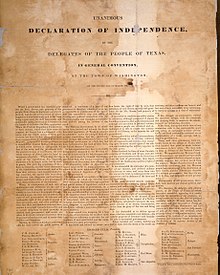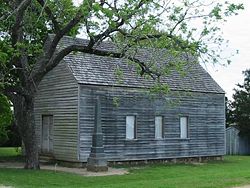Texas Declaration of Independence
This article needs additional citations for verification. (September 2020) |
| Texas Declaration of Independence | |
|---|---|
 1836 facsimile of the Texas Declaration of Independence | |
| Created | March 2, 1836 |
| Location | Engrossed copy: Texas State Library and Archives Commission |
| Author(s) | George Childress |
| Signatories | 60 delegates to the Consultation |
| Purpose | To announce and explain separation from Mexico |
| Full text | |
The Texas Declaration of Independence was the formal declaration of independence of the Republic of Texas from Mexico in the Texas Revolution. It was adopted at the Convention of 1836 at Washington-on-the-Brazos on March 2, 1836, and was formally signed the next day after mistakes were noted in the text.
Background
[edit]In October 1835, settlers in Mexican Texas launched the Texas Revolution.
However, within Austin, many struggled with understanding what the ultimate goal of the Revolution was. Some believed that the goal should be total independence from Mexico, while others sought the reimplementation of the Mexican Constitution of 1824 which enabled freedoms, including the ownership of slaves, that were not included in the 1835 constitution of Mexico, Siete Leyes.[1] To settle the issue, a convention was called for March 1836.
This convention differed from the previous Texas councils of 1832, 1833, and the 1835 Consultation. Many of the delegates to the 1836 convention were young citizens of the United States, who had only recently arrived in Texas, in violation of Mexico's immigration ban of April 1830, and many of them had fought in battles during the Texas Revolution against Mexico in 1835. The only two known native Texans to sign are Jose Francisco Ruiz and Jose Antonio Navarro.[2] Most of the delegates were members of the War Party and were adamant that Texas must declare its independence from Mexico.[3] Forty-one delegates arrived in Washington-on-the-Brazos on February 28.[3]
Development
[edit]
The convention was convened on March 1 with Richard Ellis as president.[4] The delegates selected a committee of five to draft a declaration of independence; the committee was led by George Childress and also included Edward Conrad, James Gaines, Bailey Hardeman, and Collin McKinney. The committee submitted its draft within a mere 24 hours, leading historians to speculate that Childress had written much of it before he arrived at the Convention.[5]
The declaration was approved on March 2 with no debate. Based primarily on the writings of John Locke and Thomas Jefferson, the declaration proclaimed that the Mexican government "ceased to protect the lives, liberty, and property of the people, from whom its legitimate powers are derived"[6] and complained about "arbitrary acts of oppression and tyranny."[7] Throughout the declaration are numerous references to the United States laws, rights, and customs. Omitted from the declaration was that the author and many of the signatories were citizens of the United States, occupying Texas illegally, and therefore had no legal rights in the governance of Mexico. The declaration clarifies that the men were accustomed to the laws and privileges of the United States, and were unfamiliar with the language, religion, and traditions of the nation that they were rebelling against.
The declaration officially established the Republic of Texas, although it was not officially recognized at that time by any government other than itself. The Mexican Republic still claimed the land and considered the delegates to be invaders, and the United States didn't recognize it since that would be an act of war against Mexico.[dubious – discuss]
Among others, the declaration mentions the following reasons for the separation:
- The 1824 Constitution of Mexico establishing a federal republic had been overturned and changed into a centralist military dictatorship by Gen. Antonio López de Santa Anna.
- The Mexican government had invited settlers to Texas and promised them constitutional liberty and republican government, but then reneged on these guarantees.
- Texas was in union with the Mexican state of Coahuila as Coahuila y Tejas, with the capital in distant Saltillo. Thus the affairs of Texas were decided at a great distance from the province and in the Spanish language, which the immigrants called "an unknown tongue."
- Political rights to which the settlers had previously been accustomed in the United States, such as the right to keep and bear arms and the right to trial by jury, were denied.
- No system of public education had been established.
- Attempts by the Mexican government to enforce import tariffs were called "piratical attacks" by "foreign desperadoes."
- The settlers were not allowed freedom of religion. All legal settlers were required to convert to Catholicism.
Based upon the United States Declaration of Independence, the Texas Declaration also contains many memorable expressions of American political principles:
- "the right of trial by jury, that palladium of civil liberty, and only safe guarantee for the life, liberty, and property of the citizen."
- "our arms ... are essential to our defense, the rightful property of freemen, and formidable only to tyrannical governments."
Signatories
[edit]
Sixty men signed the Texas Declaration of Independence. Three of them were born in Mexico. Fifty-seven of the sixty moved to Texas from the United States.[8] Ten of them had lived in Texas for more than six years, while one-quarter of them had been in the province for less than a year.[9] This is significant, because it indicates that the majority of signatories had moved to Texas after the Law of April 6, 1830, banning immigration, had taken effect, meaning that the majority were legally citizens of the United States, occupying Texas illegally. Fifty-nine of these men were delegates to the Convention, and one was the Convention Secretary, Herbert S. Kimble, who was not a delegate.
- Jesse B. Badgett
- George Washington Barnett
- Thomas Barnett
- Stephen W. Blount
- John W. Bower
- Asa Brigham
- Andrew Briscoe
- John Wheeler Bunton
- John S. D. Byrom
- Mathew Caldwell
- Samuel Price Carson
- George C. Childress
- William Clark, Jr.
- Robert M. Coleman
- James Collinsworth
- Edward Conrad
- William Carroll Crawford
- Lorenzo de Zavala
- Richard Ellis, President of the Convention and Delegate from Red River
- Stephen H. Everett
- John Fisher
- Samuel Rhoads Fisher
- Robert Thomas 'James' Gaines
- Thomas J. Gazley
- Benjamin Briggs Goodrich
- Jesse Grimes
- Robert Hamilton
- Bailey Hardeman
- Augustine B. Hardin
- Sam Houston
- Herbert Simms Kimble, Secretary
- William D. Lacy
- Albert H. Latimer
- Edwin O. Legrand
- Collin McKinney
- Samuel A. Maverick (from Bejar)
- Michel B. Menard
- William Menefee
- John W. Moore
- William Motley
- José Antonio Navarro
- Martin Parmer, Delegate from San Augustine
- Sydney O. Pennington
- Robert Potter
- James Power
- John S. Roberts
- Sterling C. Robertson
- José Francisco Ruiz
- Thomas Jefferson Rusk
- William. B. Scates
- George W. Smyth
- Elijah Stapp, ancestor of Brown family
- Charles B. Stewart
- James G. Swisher
- Charles S. Taylor
- David Thomas
- John Turner
- Edwin Waller
- Claiborne West
- James B. Woods
See also
[edit]Notes
[edit]- ^ Roberts and Olson (2001), p. 98.
- ^ BERNICE, STRONG (June 15, 2010). "RUIZ, JOSE FRANCISCO". tshaonline.org. Retrieved April 14, 2018.
- ^ a b Roberts and Olson (2001), p. 142.
- ^ Davis (1982), p. 38.
- ^ Roberts and Olson (2001), p. 144.
- ^ Roberts and Olson (2001), p. 145.
- ^ Roberts and Olson (2001), p. 146.
- ^ "Texas Declaration of Independence". sonofthesouth.net. Retrieved May 15, 2015.
- ^ Scott (2000), p. 122.
References
[edit]- Davis, Joe Tom (1982). Legendary Texians. Vol. 1. Austin, Texas: Eakin Press. ISBN 0-89015-336-1.
- Martinez de Vara, Art (2020). Tejano Patriot: The Revolutionary Life of Jose Francisco Ruiz, 1783 - 1840. Austin, TX: Texas State Historical Association Press. ISBN 978-1625110589.
- Roberts, Randy; Olson, James S. (2001). A Line in the Sand: The Alamo in Blood and Memory. The Free Press. ISBN 0-684-83544-4.
- Scott, Robert (2000). After the Alamo. Plano, TX: Republic of Texas Press. ISBN 978-1-55622-691-5.
External links
[edit]- Washington on the Brazos
- The Declaration of Independence, 1836, from Gammel's Laws of Texas, Vol. I., hosted by the Portal to Texas History.
- Declaration of Independence of Texas, 1836 broadside and original manuscript at the Texas State Library and Archives Commission
- Texas Independence Day, March 2 including Samuel A. Maverick's broadside copy of the Texas Declaration of Independence.
- Lone Star Junction Site: copy of The Declaration of Independence, March 2, 1836
- Special Report: Texas Independence Day by Texas Cooking
- Texas Declaration of Independence from the Handbook of Texas Online
- School Lesson: Texas Declaration of Independence
- Descendants of the Signers of the Texas Declaration of Independence
